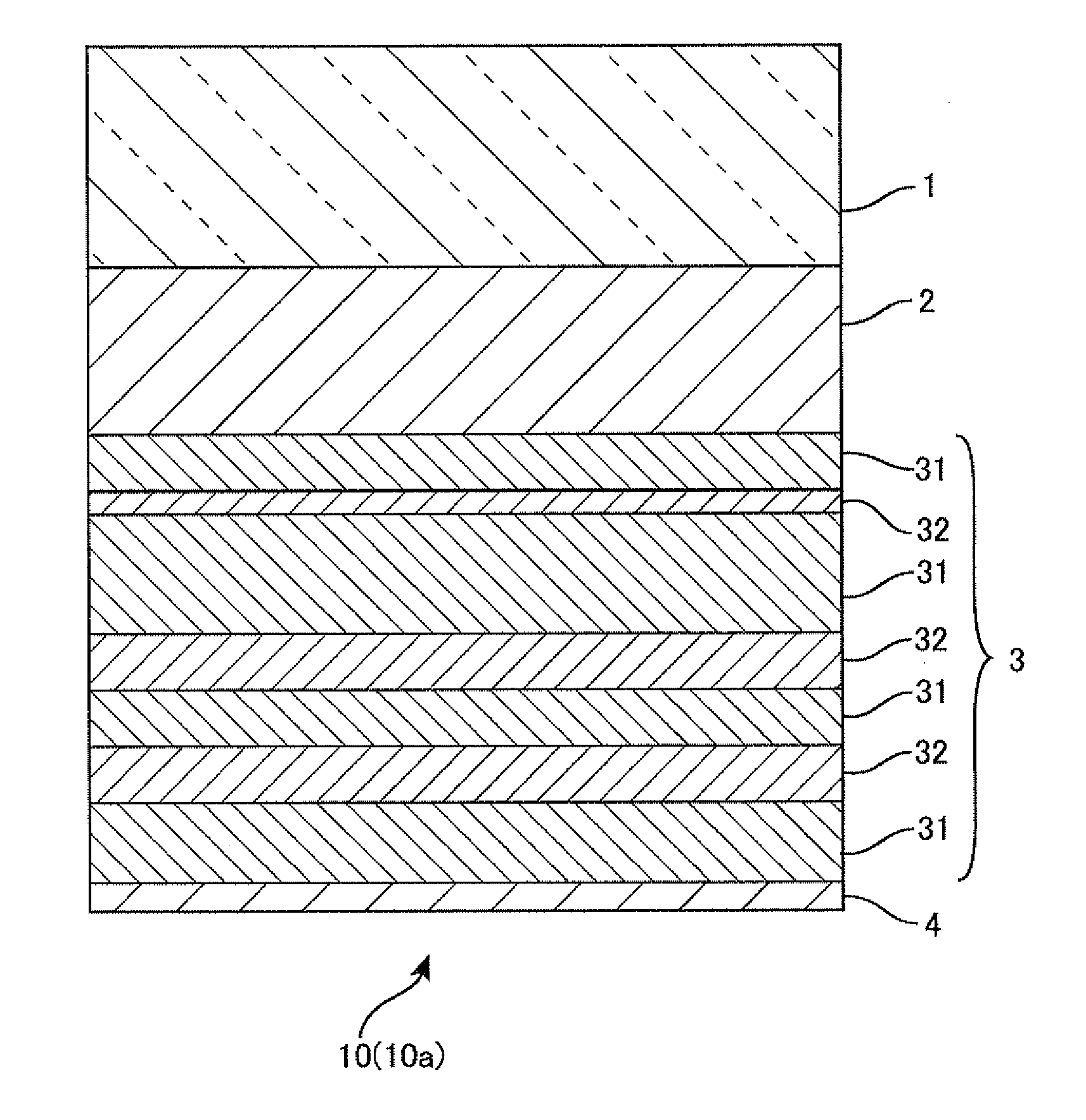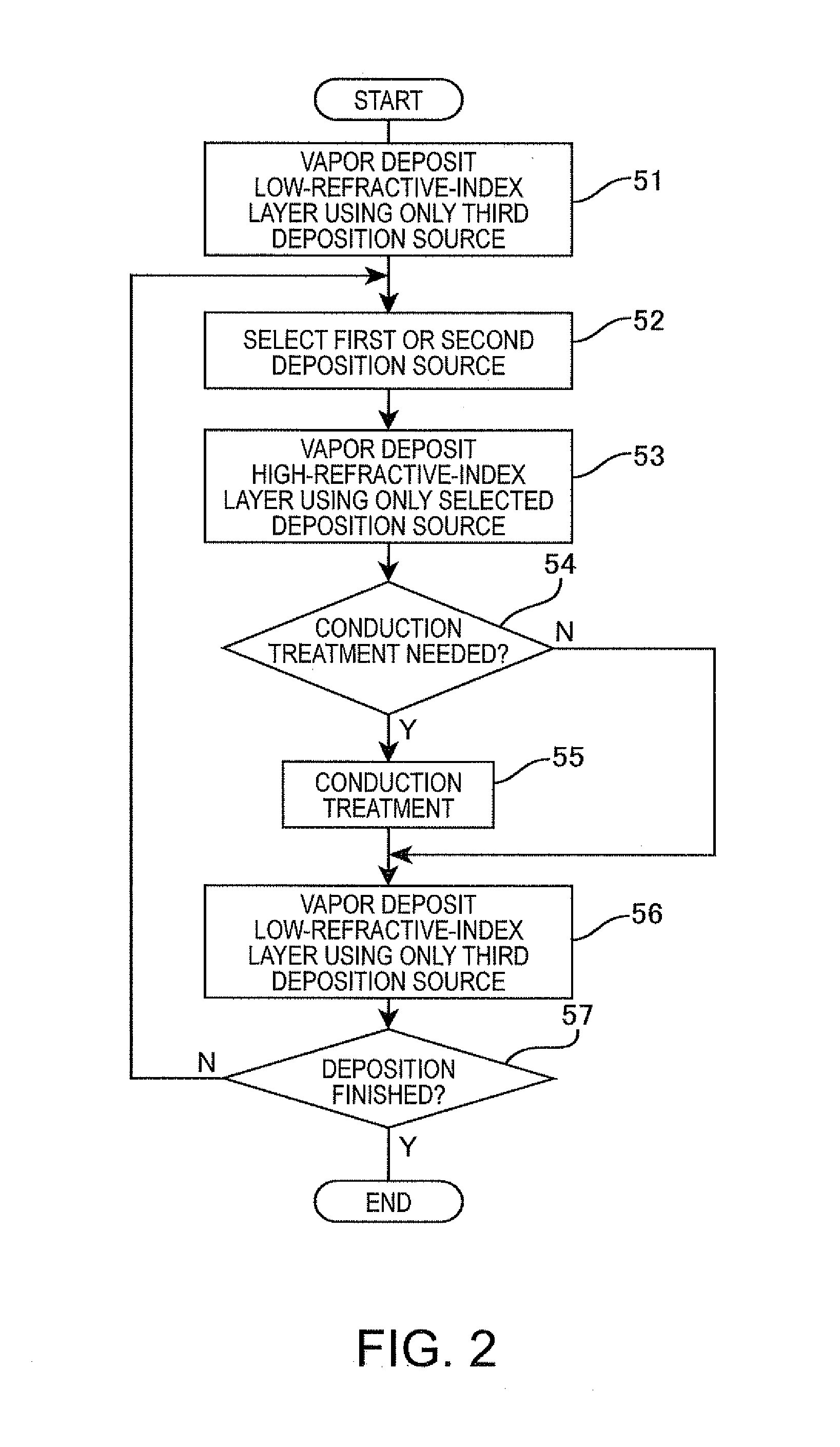Optical Article and Method for Producing Optical Article
a technology of optical articles and optical coatings, applied in the field of optical articles, can solve the problems of high complexity of antireflection coating performance and functions, difficult to ensure yield in antireflection coating formation, and high complexity of production methods. achieve the effect of high performan
- Summary
- Abstract
- Description
- Claims
- Application Information
AI Technical Summary
Benefits of technology
Problems solved by technology
Method used
Image
Examples
first embodiment
1. First Embodiment
[0051]FIG. 1 shows a cross sectional configuration of a lens of First Embodiment of the invention on one side of the lens relative to the base material at the center. FIG. 1 represents the laminated layers on the lower side of the base material I at the center. Accordingly, in the following, the layers laminated on the outer sides (upper side and lower side) will be described as upper layers. A lens (optical article) 10 (10a) includes a lens base material (optical base material) 1, a hardcoat layer 2 formed on a surface of the lens base material 1, a translucent, multilayer antireflection coating 3 formed on the hardcoat layer 2, and an antifouling layer 4 formed on the antireflection coating 3. In the following, the lens will be collectively (commonly) referred to as lens 10, and the lens of First Embodiment as lens 10a.
1.1 Lens Base Material
[0052]The lens base material 1 is not particularly limited, and may be (meth)acrylic resin. Other examples include allyl c...
first embodiment (
2. Examples of First Embodiment (Antireflection Coating: 7-Layer Structure)
[0071]Samples (Examples 1 to 5, Comparative Examples 1 to 3) were produced for the lens 10a that includes an antireflection coating 3 of a total of seven layers. FIG. 3 schematically illustrates an example of a vapor deposition apparatus used to produce the samples of Examples and Comparative Examples. FIG. 4 and FIG. 5 summarize the layer structures of the samples of Examples and Comparative Examples produced for the 7-layer antireflection coating 3. FIG. 6 summarizes the deposition conditions of the low-refractive-index layer (SiO2 layer, third-type layer) 63, the first-type high-refractive-index layer (first-type layer, ZrO2 layer) 61, and the second-type high-refractive-index layer (second-type layer, TiO2 layer) 62 included in the antireflection coating 3.
2.1 Example 1 (Sample S1)
2.1.1 Selection of Lens Base Material and Deposition of Hardcoat Layer
[0072]An eyeglass plastic lens base material (refractive...
second embodiment
3. Second Embodiment
[0145]FIG. 8 shows a cross sectional configuration of a lens of Second Embodiment of the invention on one side of the lens relative to the base material at the center. A lens (optical article) 10 (10b) includes a lens base material (optical base material) 1, a hardcoat layer 2 formed on the surface of the lens base material 1, a translucent, multilayer antireflection coating 3 formed on the hardcoat layer 2, and an antifouling layer 4 formed on the antireflection coating 3. The antireflection coating 3 has five layers (n=2), in which the first, third, and fifth layers represent the low-refractive-index layers 31, and the second and fourth layers represent the high-refractive-index layers 32. The other configuration is the same as that of First Embodiment, and explanations thereof are omitted using the same reference numerals in the appended figures.
[0146]Samples (Examples 6 and 7, Comparative Examples 4 and 5) were produced for the lens 10b that includes the 5-la...
PUM
| Property | Measurement | Unit |
|---|---|---|
| Fraction | aaaaa | aaaaa |
| Fraction | aaaaa | aaaaa |
| Fraction | aaaaa | aaaaa |
Abstract
Description
Claims
Application Information
 Login to View More
Login to View More - R&D
- Intellectual Property
- Life Sciences
- Materials
- Tech Scout
- Unparalleled Data Quality
- Higher Quality Content
- 60% Fewer Hallucinations
Browse by: Latest US Patents, China's latest patents, Technical Efficacy Thesaurus, Application Domain, Technology Topic, Popular Technical Reports.
© 2025 PatSnap. All rights reserved.Legal|Privacy policy|Modern Slavery Act Transparency Statement|Sitemap|About US| Contact US: help@patsnap.com



